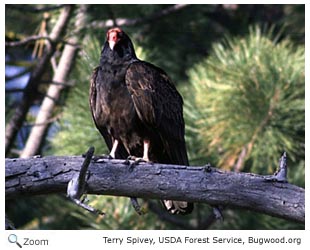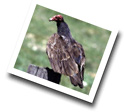Cathartidae - New World Vultures |
|
|
 There are seven species in this family. They are all found in North and South America. The birds in this family are scavengers, they eat carrion. They have bare heads, powerful legs and feet, and strong bills. There are seven species in this family. They are all found in North and South America. The birds in this family are scavengers, they eat carrion. They have bare heads, powerful legs and feet, and strong bills.
Species in this family include: the turkey vulture, the lesser yellow-headed vulture, the greater yellow-headed vulture, the black vulture, the king vulture, the California condor and the Andean condor.
 Cathartidae Photo Gallery Cathartidae Photo Gallery
World Status Key
 Least Concern Least Concern  Near Threatened Near Threatened  Vulnerable Vulnerable  Endangered Endangered  Critically Endangered Critically Endangered  Extinct in the Wild Extinct in the Wild  Extinct Extinct
Status and range is taken from ICUN Redlist. If no status is listed, there is not enough data to establish status.
US Status Key
 Threatened in US Threatened in US  Threatened in NH Threatened in NH  Endangered in US Endangered in US  Endangered in NH Endangered in NH  Breeds in NH Breeds in NH  Introduced Introduced
Status taken from US Fish and Wildlife and NH Fish and Game
New Hampshire Species |
|
North/Central American Species |
Black Vulture - Coragyps atratus 
Turkey Vulture - Cathartes aura      |
|
Lesser Yellow-headed Vulture - Cathartes burrovianus 
Greater Yellow-headed Vulture - Cathartes melambrotus 
California Condor - Gymnogyps californianus  
King Vulture - Sarcoramphus papa 
|
Additional Information
Key:  Profile Profile  Photos Photos  Video Video  Audio Audio
Andean Condor- Vultur gryphus     
The Andean condor is the largest raptor in the world.
Source: San Diego Zoo Intended Audience: Students Reading Level: Middle School
Andean Condor - Vultur gryphus     
The Andean condor has a white ruff around its neck.
Source: Arkive Intended Audience: General Reading Level: Middle School
Andean Condor - Vultur gryphus    
The Andean condor has a wingspan of up to 10½ feet.
Source: National Geographic Intended Audience: General Reading Level: Middle School
Andean Condor - Vultur gryphus    
Scientists believe that a only few thousand Andean condors remain in the wild.
Source: National Zoo Intended Audience: Students Reading Level: Middle School
Black Vulture - Coragyps atratus      
The black vulture can often be seen roosting in trees or perched on a fence post.
Source: Arkive Intended Audience: General Reading Level: Middle School
Black Vulture - Coragyps atratus       
The black vulture lays its eggs on the bare ground.
Source: Cornell Lab of Ornithology Intended Audience: General Reading Level: Middle School
Black Vulture - Coragyps atratus      
The black vulture is found from rom southern Canada to southern South America.
Source: Animal Diversity Web Intended Audience: General Reading Level: Middle School
California Condor - Gymnogyps californianus      
The California condor was once extinct in the wild. It has been re-introduced in California, Arizona and Mexico.
Source: Arkive Intended Audience: General Reading Level: Middle School
California Condor - Gymnogyps californianus     
The female California condor lays only one egg every two years
Source: National Geographic Intended Audience: General Reading Level: Middle School
California Condor - Gymnogyps californianus      
The California condor is the largest flying bird in North America.
Source: Cornell Lab of Ornithology Intended Audience: General Reading Level: Middle School
California Condor - Gymnogyps californianus      
California condors do not have vocal chords, so they only make hissing and grunting noises.
Source: San Diego Zoo Intended Audience: Students Reading Level: Middle School
California Condor - Gymnogyps californianus     
The range of the California condor once extended along the entire Pacific coast of North America.
Source: Animal Diversity Web Intended Audience: General Reading Level: Middle School
King Vulture - Sarcoramphus papa     
The king vulture has a bald head and neck with skin that can be a combination of yellow, orange, blue, purple, and red.
Source: Arkive Intended Audience: General Reading Level: Middle School
Turkey Vulture - Cathartes aura        
The turkey vulture has a bright red head and face.
Source: Arkive Intended Audience: General Reading Level: Middle School
Turkey Vulture - Cathartes aura        
The turkey vulture is found throughout the the U.S., except for in Alaska and Hawaii.
Source: Cornell Lab of Ornithology Intended Audience: General Reading Level: Middle School
Turkey Vulture - Cathartes aura        
Turkey vultures usually roost in large groups at night, but search for food alone during the day.
Source: Animal Diversity Web Intended Audience: General Reading Level: Middle School
|
 There are seven species in this family. They are all found in North and South America. The birds in this family are scavengers, they eat carrion. They have bare heads, powerful legs and feet, and strong bills.
There are seven species in this family. They are all found in North and South America. The birds in this family are scavengers, they eat carrion. They have bare heads, powerful legs and feet, and strong bills.


